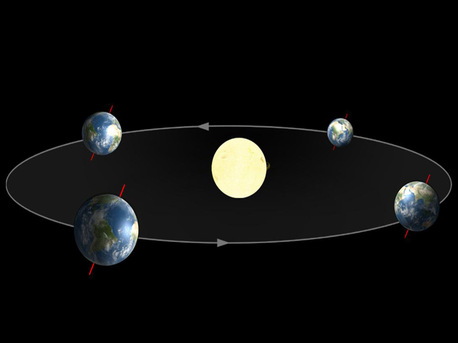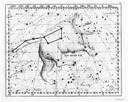Long and short days
Why do sunrise and sunset not change evenly?
 © VdS
|
Illustration of Earth's orbit around the Sun. The orbit is elliptical, rather than circular, and the Earth's axis of rotation is not perpendicular to the plane of the orbit. The non-circularity of the orbit and the tilt of the axis of rotation both contribute to the uneven changes in the times of sunrise and sunset.
While the Sun rises only a little earlier every day at the beginning of the year, it sets noticeably later every evening. For example, on February 1, 2009 in Berlin, the Sun rose 25 minutes earlier than on January 1, but it set 45 minutes later.
In spite of this 'asymmetrical' change, the 'solar noon' – the moment when the Sun appears highest above the horizon – always falls midway between sunrise and sunset. The amount of time between sunrise and solar noon remains more or less the same as the amount of time between solar noon and sunset.
Thus, the days get longer but the Sun actually only rises a little bit earlier every day and still reaches its highest point in the sky at midday. This means that the Sun reaches this highest point with a 'delay' that increases with every day. How can this happen?
For one thing, the Earth does not orbit the Sun at a constant speed, as its orbit is slightly elliptical rather than perfectly circular. This means that the Sun passes through the sky at a slightly different speed from day to day, sometimes a bit faster, sometimes a bit slower. For another, the Sun's path across the sky is slightly different every day, depending on the time of the year.
For another, the Sun's path across the sky is slightly different every day, depending on the time of the year. The reason for this is that the Earth's axis of rotation, which connects the geographic North and South Poles, is not perpendicular to its orbit: depending on the time of the year, either the northern or the southern hemisphere is tilted towards the Sun.
German Aerospace Center
Long and short days
Why do sunrise and sunset not change evenly?
 © VdS
|
Illustration of Earth's orbit around the Sun. The orbit is elliptical, rather than circular, and the Earth's axis of rotation is not perpendicular to the plane of the orbit. The non-circularity of the orbit and the tilt of the axis of rotation both contribute to the uneven changes in the times of sunrise and sunset.
While the Sun rises only a little earlier every day at the beginning of the year, it sets noticeably later every evening. For example, on February 1, 2009 in Berlin, the Sun rose 25 minutes earlier than on January 1, but it set 45 minutes later.
In spite of this 'asymmetrical' change, the 'solar noon' – the moment when the Sun appears highest above the horizon – always falls midway between sunrise and sunset. The amount of time between sunrise and solar noon remains more or less the same as the amount of time between solar noon and sunset.
Thus, the days get longer but the Sun actually only rises a little bit earlier every day and still reaches its highest point in the sky at midday. This means that the Sun reaches this highest point with a 'delay' that increases with every day. How can this happen?
For one thing, the Earth does not orbit the Sun at a constant speed, as its orbit is slightly elliptical rather than perfectly circular. This means that the Sun passes through the sky at a slightly different speed from day to day, sometimes a bit faster, sometimes a bit slower. For another, the Sun's path across the sky is slightly different every day, depending on the time of the year.
For another, the Sun's path across the sky is slightly different every day, depending on the time of the year. The reason for this is that the Earth's axis of rotation, which connects the geographic North and South Poles, is not perpendicular to its orbit: depending on the time of the year, either the northern or the southern hemisphere is tilted towards the Sun.
German Aerospace Center











